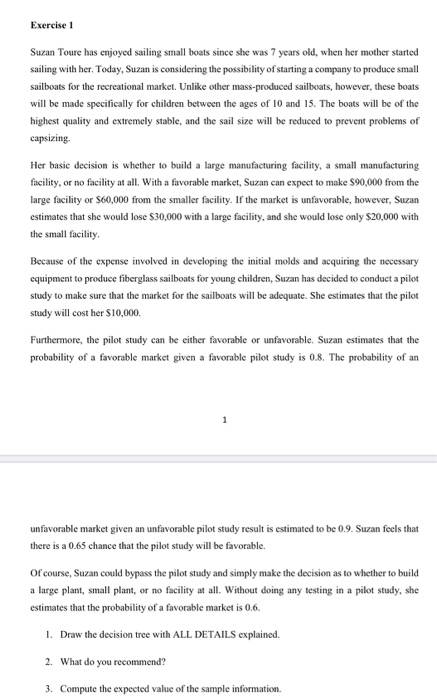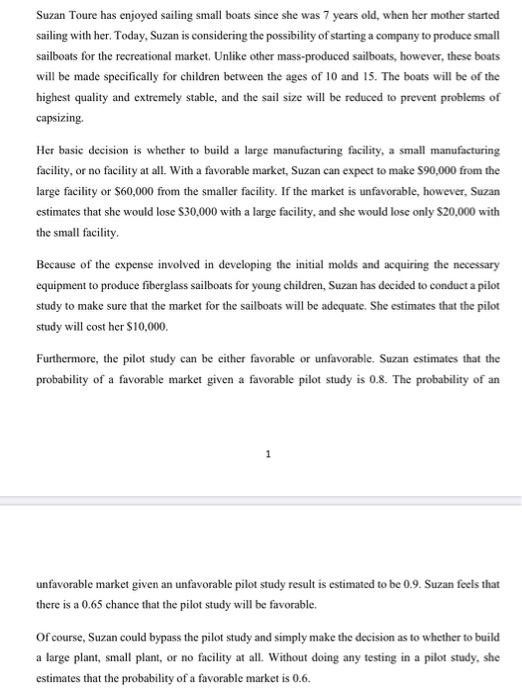Exercise 1 Suzan Toure has enjoyed sailing small boats since she was 7 years old, when her mother started sailing with her. Today, Suzan is considering the possibility of starting a company to produce small sailboats for the recreational market. Unlike other mass-produced sailboats, however, these boats will be made specifically for children between the ages of 10 and 15. The boats will be of the highest quality and extremely stable, and the sail size will be reduced to prevent problems of capsizing Her basic decision is whether to build a large manufacturing facility, a small manufacturing facility, or no facility at all. With a favorable market, Suzan can expect to make $90,000 from the large facility or $60,000 from the smaller facility. If the market is unfavorable, however, Suzan estimates that she would lose $30,000 with a large facility, and she would lose only $20,000 with the small facility Because of the expense involved in developing the initial molds and acquiring the necessary equipment to produce fiberglass sailboats for young children, Suzan has decided to conduct a pilot study to make sure that the market for the sailboats will be adequate. She estimates that the pilot study will cost her $10,000. Furthermore, the pilot study can be either favorable or unfavorable. Suzan estimates that the probability of a favorable market given a favorable pilot study is 0.8. The probability of an unfavorable market given an unfavorable pilot study result is estimated to be 0.9. Suzan feels that there is a 0.65 chance that the pilot study will be favorable. Of course, Suzan could bypass the pilot study and simply make the decision as to whether to build a large plant, small plant, or no facility at all. Without doing any testing in a pilot study, she estimates that the probability of a favorable market is 0.6. 1. Draw the decision tree with ALL DETAILS explained. 2. What do you recommend? 3. Compute the expected value of the sample information. Suzan Toure has enjoyed sailing small boats since she was 7 years old, when her mother started sailing with her. Today, Suzan is considering the possibility of starting a company to produce small sailboats for the recreational market. Unlike other mass-produced sailboats, however, these boats will be made specifically for children between the ages of 10 and 15. The boats will be of the highest quality and extremely stable, and the sail size will be reduced to prevent problems of capsizing Her basic decision is whether to build a large manufacturing facility, a small manufacturing facility, or no facility at all. With a favorable market, Suzan can expect to make $90,000 from the large facility or $60,000 from the smaller facility. If the market is unfavorable, however, Suzan estimates that she would lose S30,000 with a large facility, and she would lose only $20,000 with the small facility Because of the expense involved in developing the initial molds and acquiring the necessary equipment to produce fiberglass sailboats for young children, Suzan has decided to conduct a pilot study to make sure that the market for the sailboats will be adequate. She estimates that the pilot study will cost her $10,000. Furthermore, the pilot study can be either favorable or unfavorable. Suzan estimates that the probability of a favorable market given a favorable pilot study is 0.8. The probability of an unfavorable market given an unfavorable pilot study result is estimated to be 0.9. Suzan feels that there is a 0.65 chance that the pilot study will be favorable. Of course, Suzan could bypass the pilot study and simply make the decision as to whether to build a large plant, small plant, or no facility at all. Without doing any testing in a pilot study, she estimates that the probability of a favorable market is 0.6








